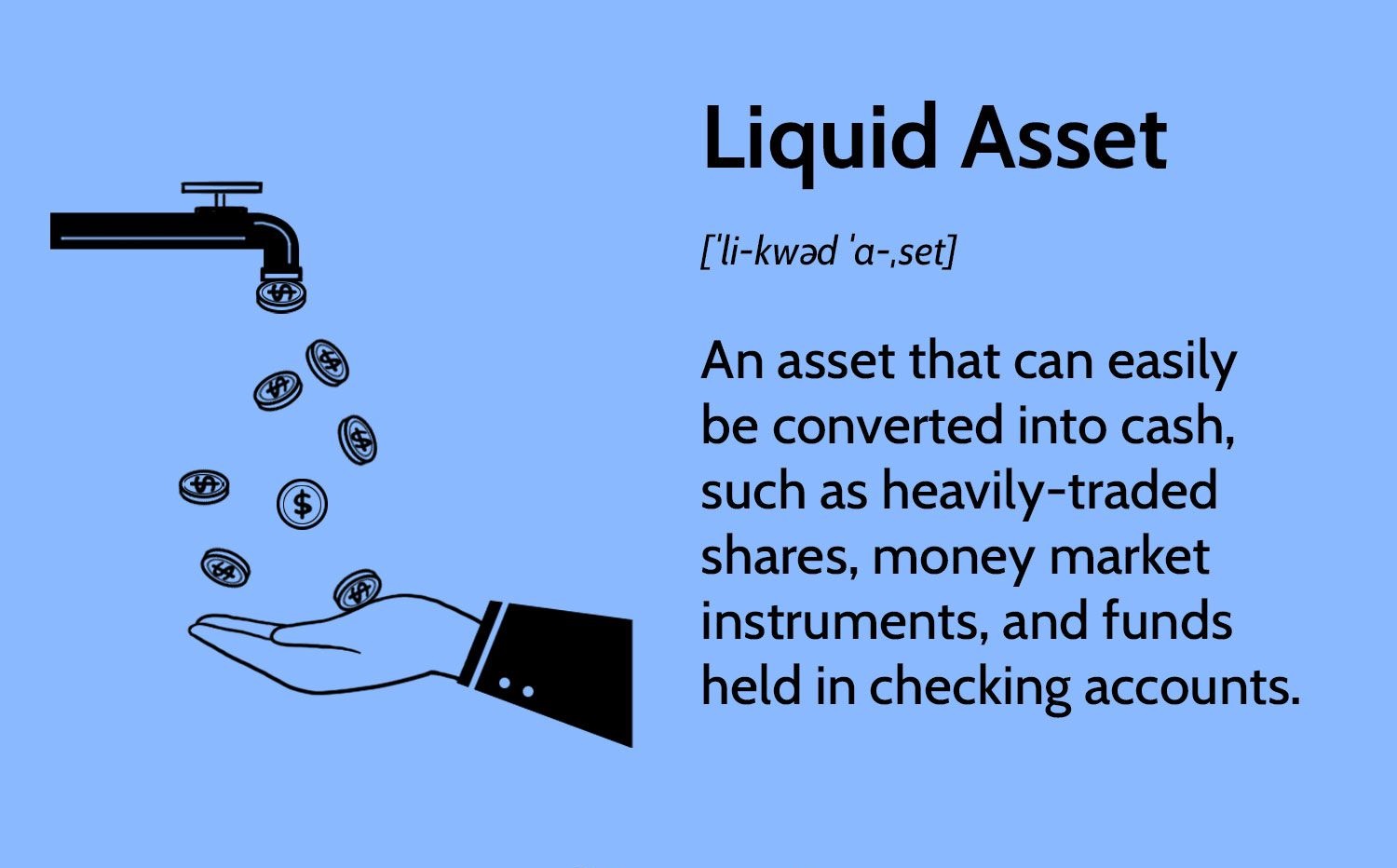Introduction
When it comes to investing, one of the key considerations is liquidity. The ability to quickly and easily convert an investment into cash is an important aspect for many investors, especially those who may need to access their funds in the short term or react to changing market conditions. This is where liquid investments come into play.
Liquid investments refer to assets that can be easily bought or sold in the market without causing significant disruptions to their underlying value. Unlike illiquid investments, which may take time to sell or have limited buyers, liquid investments offer investors the flexibility and convenience of converting their holdings into cash whenever needed.
For individuals or businesses looking to preserve capital, finance unexpected expenses, or take advantage of investment opportunities, having a portion of their portfolio allocated to liquid investments is a prudent strategy. By understanding the characteristics, examples, advantages, disadvantages, and factors to consider when investing in liquid assets, investors can make informed decisions to align their financial goals with their risk tolerance.
Throughout this article, we will delve deeper into the world of liquid investments. We will explore the various features and benefits that make them appealing, as well as the potential pitfalls that investors should be aware of. Whether you are a beginner investor just starting out or a seasoned professional seeking to diversify your portfolio, this guide will provide you with a solid foundation to navigate the world of liquid investments with confidence.
Definition of Liquid Investments
Liquid investments are assets that can be easily converted into cash without a significant impact on their market value. These assets are characterized by their high level of liquidity, meaning they can be bought or sold quickly and at a narrow bid-ask spread, often without incurring significant transaction costs.
Common examples of liquid investments include stocks, bonds, money market instruments, and exchange-traded funds (ETFs). These assets are traded on organized markets, such as stock exchanges, where buyers and sellers can easily come together to execute transactions.
There are several factors that contribute to the liquidity of an investment:
- Marketability: Liquid investments have a broad investor base and significant trading volume, which ensures that there is a constant supply of buyers and sellers in the market.
- Convertibility: Liquid investments can be swiftly and easily converted into cash without the need for complex financial arrangements or significant delays.
- Price stability: Liquid investments tend to have stable and transparent pricing mechanisms, with narrow bid-ask spreads. This allows investors to buy or sell at competitive prices without large price fluctuations.
- Regulatory framework: The existence of well-defined regulations and oversight helps maintain market integrity and investor confidence, further enhancing the liquidity of these investments.
It is important to note that the liquidity of an investment can vary over time and under different market conditions. While most liquid investments can be easily bought or sold on a daily basis, there may be instances where market conditions, such as high volatility or limited liquidity, can impact the ease and speed of completing a transaction.
Overall, liquid investments provide investors with the flexibility to access their funds quickly, respond to market changes, and take advantage of investment opportunities. However, it is crucial to understand the characteristics, advantages, and disadvantages of these investments before incorporating them into your portfolio. By doing so, you can make well-informed decisions that align with your financial goals and risk tolerance.
Characteristics of Liquid Investments
Liquid investments possess certain key characteristics that distinguish them from other asset classes. Understanding these characteristics will help investors gauge the level of liquidity and make informed decisions about incorporating these investments into their portfolios. Below are some of the main characteristics of liquid investments:
- High trading volume: Liquid investments generally have a high trading volume, meaning that there is a significant amount of buying and selling activity in the market. This ample liquidity ensures that investors can easily enter or exit their positions without causing drastic price changes.
- Narrow bid-ask spread: The bid-ask spread is the difference between the highest price a buyer is willing to pay (bid) and the lowest price a seller is willing to accept (ask). Liquid investments typically have a narrow bid-ask spread, which means that the difference between the buying and selling prices is relatively small. This reduces transaction costs and allows investors to execute trades at competitive prices.
- Real-time pricing: Liquid investments are traded on organized financial markets, such as stock exchanges, where prices are continually updated in real-time. Investors can access transparent and up-to-date information about the current market prices, enabling them to make well-informed decisions about buying or selling.
- Availability of market makers: Market makers are individuals or entities that facilitate trading by providing liquidity to the market. They are always ready to buy or sell a particular liquid investment at quoted prices, ensuring a continuous flow of transactions. The presence of market makers enhances the liquidity of the investment by increasing the number of parties willing to trade.
- Regulatory oversight: Liquid investments are subject to regulatory oversight by relevant authorities, such as securities commissions and financial regulators. These regulations help maintain market integrity, protect investors, and ensure fair and transparent trading practices.
It is important to keep in mind that the level of liquidity for an investment can vary over time and under different market conditions. While most liquid investments can be easily bought or sold, there may be instances where market disruptions or high volatility can temporarily reduce liquidity. Therefore, it is essential for investors to stay informed about market conditions and make well-timed decisions to minimize potential risks associated with liquidity fluctuations.
By considering these characteristics and weighing them against your investment goals, time horizon, and risk tolerance, you can determine whether liquid investments are suitable additions to your investment portfolio.
Examples of Liquid Investments
Liquid investments span across various asset classes, offering investors a wide range of options to choose from. Here are some common examples of liquid investments:
- Stocks: Shares of publicly traded companies are a highly liquid investment. They can be bought and sold on stock exchanges, where investors can easily access real-time prices and execute trades.
- Bonds: Government bonds, corporate bonds, and other fixed-income securities are considered liquid investments. They can be traded on bond markets, allowing investors to buy or sell them before their maturity date.
- Exchange-Traded Funds (ETFs): ETFs are investment funds that trade on stock exchanges. They offer investors exposure to a diversified portfolio of assets, such as stocks, bonds, commodities, or even other ETFs. The ability to buy or sell ETF shares throughout the trading day makes them highly liquid.
- Money Market Instruments: Money market instruments include Treasury bills, commercial paper, certificates of deposit (CDs), and other short-term debt securities. These investments are known for their high degree of liquidity and are often used as a parking place for cash in the short term.
- Foreign Exchange (Forex): The forex market is the largest and most liquid financial market globally. Currency pairs can be easily bought or sold, providing investors with opportunities to speculate or hedge against international currency fluctuations.
These examples represent just a few of the many liquid investments available to investors. It is important to note that the liquidity of specific investments may vary based on factors such as market conditions, trading volume, and the availability of market makers.
When considering investing in liquid assets, it is essential to carefully evaluate each investment’s characteristics, such as risk-return profiles, fees and expenses, and diversification potential. This will help you make informed decisions and construct a portfolio that aligns with your investment goals and risk tolerance.
Remember, diversifying your investments across various liquid assets can help spread risk and provide liquidity when needed, ensuring a well-rounded and flexible investment strategy.
Advantages of Liquid Investments
Liquid investments offer several advantages that make them attractive to investors looking to build a well-balanced portfolio. Here are some of the key advantages of investing in liquid assets:
- Flexibility and Accessibility: One of the primary advantages of liquid investments is the ability to easily convert them into cash. This provides investors with the flexibility to access their funds when needed, whether it’s for unexpected expenses or taking advantage of new investment opportunities.
- Quick Response to Market Changes: Liquid investments allow investors to swiftly respond to changing market conditions. For example, if economic indicators suggest a potential market downturn, investors can quickly sell their liquid assets to mitigate losses or reallocate their investments to more promising opportunities.
- Lower Transaction Costs: Compared to illiquid investments, liquid assets typically have lower transaction costs. The high trading volumes and narrow bid-ask spreads associated with liquid investments facilitate more efficient buying and selling, minimizing the impact of transaction fees and enabling investors to optimize their returns.
- Greater Transparency: Liquid investments are traded on organized financial markets, which provides investors with access to transparent and real-time pricing information. This transparency allows investors to make well-informed decisions based on up-to-date market data.
- Diversification Opportunities: Liquid investments offer a wide range of options across different asset classes and sectors. This diversification potential allows investors to spread their risk and reduce the impact of volatility in any particular investment, thereby enhancing the stability of their overall portfolio.
- Liquidity as a Risk Mitigation Strategy: Integrating liquid investments into a portfolio can act as a risk mitigation strategy. The ability to quickly convert assets into cash provides a cushion during market downturns or financial emergencies, allowing investors to meet their liquidity needs without having to sell off other long-term investments at potentially unfavorable prices.
By incorporating liquid investments into your portfolio, you can take advantage of these benefits and maintain a level of flexibility and responsiveness to market conditions. However, it is important to consider the potential disadvantages and risks associated with these investments to make informed decisions and align your investment choices with your financial goals and risk tolerance.
Disadvantages of Liquid Investments
While liquid investments offer numerous advantages, it’s important to be aware of the potential disadvantages and risks associated with these assets. Here are some of the main drawbacks of investing in liquid investments:
- Volatility and Price Fluctuations: Liquid investments, such as stocks and ETFs, are often more susceptible to price fluctuations and market volatility compared to other asset classes. Sudden market downturns can result in significant declines in the value of these investments, which may require investors to hold onto their positions for longer periods to recoup losses.
- Short-Term Focus: The liquidity and ease of trading associated with these investments can sometimes lead investors to develop a short-term trading mentality. This focus on short-term gains can distract from long-term investment strategies and potentially result in missed opportunities or reduced returns over time.
- Emotional Decision-Making: In highly liquid markets, the constant availability of buying and selling opportunities can lead to impulsive and emotionally-driven investment decisions. Such behavior can be detrimental to long-term investment objectives, as it may result in a failure to adhere to a disciplined investment strategy.
- Market Manipulation and Insider Trading: The liquidity of certain investments can make them susceptible to market manipulation and insider trading. In such cases, unethical practices may distort the true market value of the investment and negatively impact shareholders or other investors.
- External Factors: Liquid investments may be influenced by external factors beyond an investor’s control, such as changes in interest rates, economic conditions, political events, or regulatory changes. These external factors can lead to increased volatility and make it challenging to accurately predict the future performance of these assets.
- Opportunity Cost: Liquid investments often offer lower potential returns compared to illiquid assets, such as venture capital or private equity. While the liquidity provides flexibility, it can come at the expense of potentially higher long-term gains that could be realized through long-term illiquid investments.
It’s important for investors to weigh these disadvantages against the advantages of liquidity when making investment decisions. Evaluating your risk tolerance, investment goals, and time horizon will help you strike a balance between liquidity and potential returns that best align with your financial objectives.
Furthermore, diversifying your portfolio by combining liquid and illiquid investments can help offset some of the disadvantages associated with liquid investments, as it allows for a broader range of asset classes and risk profiles.
Factors to Consider when Investing in Liquid Investments
Investing in liquid assets requires careful consideration of various factors to ensure that you make informed investment decisions. Here are some key factors to consider when investing in liquid investments:
- Investment Objectives: Clearly define your investment objectives. Are you seeking income, capital appreciation, or a combination of both? Understanding your goals will help you identify suitable liquid investments that align with your financial aspirations.
- Risk Tolerance: Assess your risk tolerance, which is the level of uncertainty or potential loss you are willing to accept. Liquid investments can be subject to volatility, and understanding your risk tolerance will help you select investments that match your comfort level.
- Market Research: Conduct thorough market research to evaluate the potential investment opportunities. Study the performance history, fundamental analysis, and key trends relating to the specific investment you are considering.
- Liquidity Needs: Determine your liquidity needs. How quickly might you need to access your invested funds? Consider your short-term financial goals, emergencies, or any foreseeable major expenses, and ensure that you allocate an appropriate portion of your portfolio to liquid investments.
- Diversification: Diversifying your investment portfolio is crucial. Allocate your investments across multiple asset classes, sectors, and geographical regions to spread risks and enhance potential returns. Liquidity should be considered in the context of your overall portfolio diversification strategy.
- Costs and Fees: Evaluate the costs associated with investing in liquid assets. Consider brokerage fees, management fees for mutual funds or ETFs, and any other costs related to buying, selling, or holding the investment. These costs can impact your overall returns.
- Market Stability: Assess the stability of the market and its potential impact on the liquidity and performance of your chosen investments. Research the regulatory environment, economic conditions, and any geopolitical factors that may influence the market’s stability.
- Professional Guidance: If needed, seek professional guidance from financial advisors who specialize in investing in liquid assets. They can provide valuable insights, knowledge, and personalized advice to help you navigate the complexities of the investment landscape.
By considering these factors, you can make more informed decisions and develop an investment strategy that suits your financial goals, risk tolerance, and liquidity needs. Regularly reviewing and reassessing your investments will also allow you to adapt to changing market conditions and ensure that your portfolio remains aligned with your objectives.
Remember, investing in liquid assets requires a balanced approach, combining liquidity with other important factors such as diversification, risk management, and long-term investment planning.
Conclusion
Liquid investments play a crucial role in a well-rounded investment portfolio. Their high level of liquidity, flexibility, and accessibility make them attractive to investors seeking to balance their need for cash flow and long-term growth. By understanding the definition, characteristics, advantages, and disadvantages of liquid investments, investors can make informed decisions that align with their financial goals, risk tolerance, and liquidity requirements.
Throughout this article, we explored the concept of liquid investments and discussed some common examples, including stocks, bonds, ETFs, money market instruments, and forex. We also highlighted the advantages of liquid investments, such as flexibility, quick response to market changes, lower transaction costs, greater transparency, diversification opportunities, and their use as a risk mitigation strategy.
However, it is important to acknowledge the potential disadvantages of liquid investments, such as price volatility, short-term focus, emotional decision-making, market manipulation risks, external factors, and the opportunity cost of potentially higher returns from illiquid investments.
When investing in liquid assets, it’s crucial to consider factors such as investment objectives, risk tolerance, market research, liquidity needs, diversification, costs and fees, market stability, and seeking professional guidance if needed. Taking a comprehensive approach to investing in liquid assets can help optimize returns while managing risks.
In conclusion, incorporating liquid investments into your portfolio allows for flexibility, quick access to funds, and the ability to adapt to changing market conditions. However, it is important to strike a balance between liquid and illiquid investments, diversify your portfolio, and make informed decisions based on a thorough understanding of the investment landscape. By doing so, you can navigate the world of liquid investments with confidence and work towards achieving your long-term financial goals.

























